7.4 Technical Provisions
General: Trails shall comply with 7.4.
7.4.1 Surface.
The trail tread surface, including resting intervals and passing spaces, shall be both firm and stable.
7.4.2 Clear Tread Width.
The clear tread width of the trail shall be at least 36 inches (915 mm).
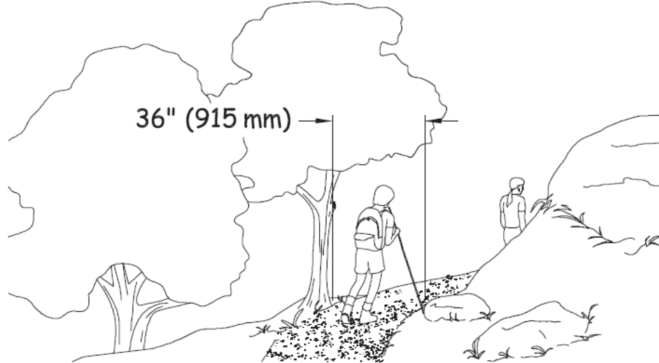
EXCEPTION: Where a condition for an exception prevents achieving the required width, the clear tread width may be reduced to 32 inches (815 mm) minimum. If the condition for an exception prevents achieving the reduced width of 32 inches, comply to the extent practicable.
7.4.3 Slope.
Trail running slopes (grades) and cross slopes shall comply with sections 7.4.3.1 and 7.4.3.2.
7.4.3.1 Running Slope (Grade).
The running slope (grade) of trail segments shall comply with this section and shall be consistent over the distances cited.
-
Trail running slope (grade) of up to 1:20 (5 percent) is permitted for any distance.
-
The running slope of any segment of a trail shall not be steeper than 1:8 (12 percent).
-
No more than 30 percent of the total trail length may exceed a running slope (grade) of 1:12 (8.33 percent).
-
Where the running slope (grade) of a segment of a trail is steeper than 1:20 (5 percent), the maximum length of the segment shall be in accordance with Table 7.4.3.1, and a resting interval complying with 7.4.4 shall be provided at each end of the segment.
Table 7.4.3.1 Trail Running Slope (Grade) and Resting Intervals
|
Running Slope of Trail Segment |
Maximum Length of Segment Between Resting Intervals |
|
| Steeper Than | But Not Steeper Than | |
|
1:20 (5 percent) |
1:12 (8.33 percent) |
200 feet (61 m) |
|
1:12 (8.33 percent) |
1:10 (10 percent) |
30 feet (9 m) |
|
1:10 (10 percent) |
1:8 (12 percent) |
10 feet (3050 mm) |
7.4.3.2 Cross Slope.
The cross slope shall not exceed 1:20 (5 percent). Where the surface is paved or is elevated above the natural ground, the cross slope shall not be steeper than 1:48 (2 percent).
7.4.4 Resting Intervals.
Resting intervals shall comply with 7.4.4. Where the trail grade exceeds 1:20 (5 percent), resting intervals shall be provided as specified in Table 7.4.3.1.
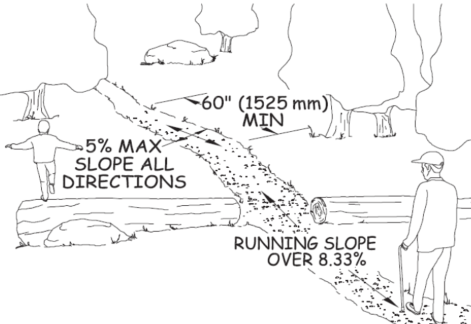
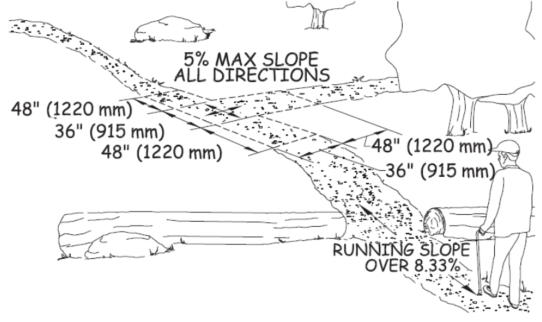
7.4.4.1 Length.
The resting interval length shall be 60 inches (1525 mm) long minimum.
7.4.4.2 Width.
Where resting intervals are provided within the trail tread, resting intervals shall be at least as wide as the widest segment of the trail tread leading to the resting interval. Where resting intervals are provided adjacent to the trail tread, the resting interval clear width shall be 36 inches (915 mm) minimum.
7.4.4.3 Slope.
The slope of a resting interval shall not exceed 1:20 (5 percent) in any direction. Where the surface is paved or is elevated above the natural ground, the slope shall not be steeper than 1:48 (2 percent) in any direction.
7.4.4.4 Turning Space.
Where resting intervals are provided adjacent to the trail tread, a turning space complying with ABAAS section 304.3.2 shall be provided. Vertical alignment between the trail tread, turning space, and resting interval shall be nominally level. The trail tread, turning space, and resting interval may overlap.
7.4.5 Passing Spaces.
Trails with a clear tread width less than 60 inches (1525 mm) shall provide passing spaces complying with 7.4.5 at intervals of 1000 feet (300 m) maximum. A passing space must also be provided at the end of any segment of trail that meets the requirements of 7.4, if the full length of the trail does not meet the requirements. Passing spaces and resting intervals may coincide or overlap.
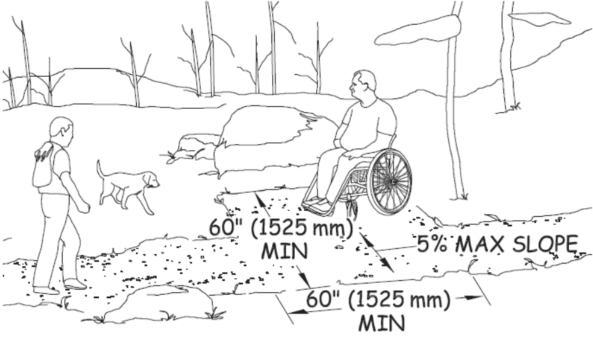
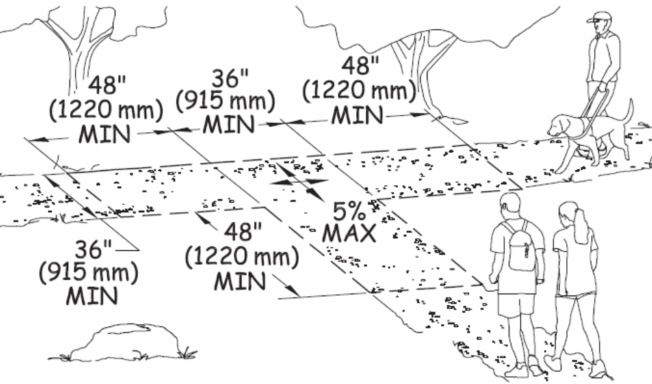
7.4.5.1 Size.
The passing space shall be either:
-
A space 60 inches (1525 mm) minimum by 60 inches (1525 mm) minimum; or
-
The intersection of two trails providing a T-shaped space complying with ABAAS section 304.3.2 where the base and the arms of the T-shaped space extend 48 inches (1220 mm) minimum beyond the intersection. Vertical alignment at the intersection of the trails that form the T-shaped space shall be nominally level.
7.4.5.2 Slope.
The cross slope of a passing space shall not exceed 1:20 (5 percent) in any direction.
7.4.5.3 Non-complying Segment Ends.
Where a segment of the trail does not comply with 7.4, a passing space shall be located at the end of each adjacent trail segment that does comply with 7.4.
7.4.6 Tread Obstacles.
Tread obstacles on trails shall not exceed 2 inches (50 mm) in height measured vertically to the highest point. Where the trail surface is paved or is elevated above the natural ground, tread obstacles shall not exceed ½ inch (13 mm) in height measured vertically to the highest point.
7.4.7 Openings.
Openings in trail tread surfaces, trail resting spaces, and trail passing spaces shall be small enough to prevent passage of a 1/2 inch- (13 mm-) diameter sphere. Where possible, elongated openings should be placed perpendicular, or as close to perpendicular as possible, to the dominant direction of travel.
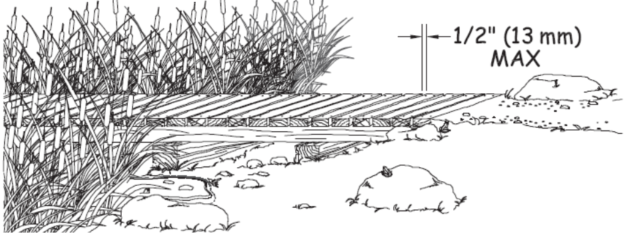
Exception: Where openings that do not permit the passage of a ½ inch (6.4 mm) sphere cannot be provided due to a condition for an exception, openings that do not permit passage of a ¾ inch (19 mm) sphere shall be permitted.
7.4.8 Protruding Objects.
Constructed features, including signs, shall not extend into the trail tread more than 4 inches (100 mm) between 27 inches (685 mm) and 80 inches (2030 mm) above the surface of the trail.
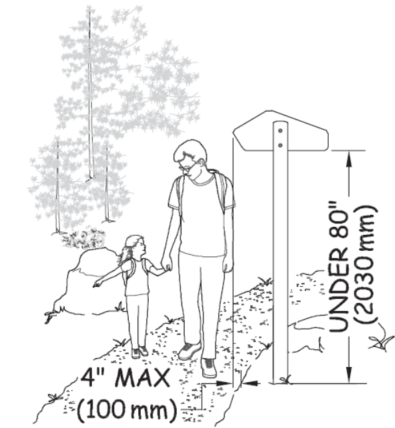
7.4.9 Trail Facilities.
Where provided on trails, facilities shall comply with the applicable provisions of the FSORAG. ORARs are not required at or between facilities on trails.
Exception. When the surface of the required clear ground space for trail facilities is not paved or is not elevated above the natural ground, slopes not steeper than 1:20 (5 percent) shall be permitted where necessary for drainage.
7.4.10 Trailheads.
Trailheads shall comply with 7.4.10.
7.4.10.1 Outdoor Constructed Features.
Where provided within trailheads each outdoor constructed features such as parking spaces, toilets, or camp sites shall comply with the applicable portions of the FSORAG and ABAAS.
7.4.10.2 Outdoor Recreation Access Routes (ORARs).
At least one outdoor recreation access route complying with FSORAG section 2.0 shall connect the following places at trailheads:
-
Accessible parking spaces or other arrival point;
-
Starting point of the trail; and
-
Accessible outdoor constructed features, elements, spaces, and facilities within the trailhead.
Exception 1. In alterations to existing trailheads, where a condition for exception prohibits compliance with a technical provision, the ORAR shall comply with FSORAG 2.0 to maximum extent practicable.
Exception 2. Where elements, spaces, or outdoor constructed features are altered at trailheads but the circulation path is not altered, an outdoor recreation access route shall not be required.
7.4.11 Trailhead Signs.
Where new trailhead information signs are provided at trailheads on newly constructed or altered trails, they shall comply with 7.4.11.
7.4.11.1 Clear Space.
Trailhead signs shall be located centered at the back of a 30- by 48-inch (760- by 1,220-millimeter) minimum clear floor or ground space. The clear space shall not overlap the trail width but may overlap a resting space or passing space. The slope of the clear space shall not exceed 1:20 (5 percent) in any direction.
7.4.11.2 Sign Contents.
Where new trail information signs are provided at trailheads on newly constructed or altered trails, regardless of whether the trail is accessible, the signs shall include at minimum the following information:
-
Length of the trail or trail segment
-
Surface type
-
Typical and minimum tread width
-
Typical and maximum running slope
-
Typical and maximum cross slope
-
A statement that the posted information reflects the condition of the trail when it was constructed or assessed, including the date of the construction or assessment
Where more extensive trail information is provided (e.g., an aerial map of the trail and related facilities), the location of specific trail features and obstacles that do not comply with the technical provisions in 7.4 should be identified and a profile of the trail grade should be included.
7.4.11.3 Reach Ranges.
If materials need to be obtained from or manipulated on a sign or kiosk, the sign or kiosk shall be designed to meet the reach ranges in section 308 of the ABAAS.
7.4.12 Gates and Barriers.
Where gates or barriers are constructed to control access to trails, gates and barriers shall comply with 7.4.12.
7.4.12.1 Clear Width.
Gate openings and openings in barriers for hiker passage shall provide a clear width of 36 inches (915 mm), complying with ODAAG, section 1017.3 Clear Tread Width.
7.4.12.2 Gate Hardware.
Gate hardware shall comply with operable controls requirements in ABAAS section 309.4 and 404.2.7.

User Comments/Questions
Add Comment/Question